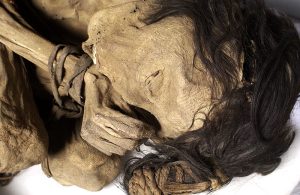
A recent analysis of the DNA of the controversial Nazca Mummies show that 30 percent of their DNA is “not from any known species,” according to Mexican journalist Jaime Maussan; although he previously said that this portion of their genetic makeup was “unknown”, this update purports that the DNA specifically belongs to an unidentified species.
In September 2023, two of the diminutive mummies were presented as part of an unofficial hearing held before the General Congress of the United Mexican States regarding the existence of UFOs. The hearing included presentations from numerous experts from around the world on the topic; the mummies themselves, reportedly recovered from a diatomaceous earth mine in Peru’s Cusco Region in 2017, have three fingers on their hands, no teeth, and have been carbon dated to be more than 1,000 years old.
The bodies of the mummies have been determined to be those of previously-living creatures, rather than pieced together from parts of animals of different species, according to researchers from Peru’s San Luis Gonzaga National University. One of the mummies also has a metallic object embedded in its chest made of osmium, one of the rarest metals in existence.
On November 30 Maussan clarified that although 70 percent of the creatures’ DNA was human; the other 30 percent was from an “unknown species”: the previous “unknown” description, being somewhat ambiguous, could have indicated that that portion of the genetic code couldn’t be read; this new description of “unknown species” implies that the genetic code involved is indeed legible, but does not match that of any previously-catalogued species.
“These specimen are not part of our terrestrial evolution,” Maussan stated at the September hearings. “These aren’t beings that were found after a UFO wreckage. They were found in diatom (algae) mines, and were later fossilized.”
The creatures stand roughly two feet tall and have disproportionately large heads with large eye sockets. One individual also has a brassiere-like metal object implanted in its chest—the previously mentioned osmium object—along with what appear to be unhatched eggs in its lower abdomen.
Subscribers, to watch the subscriber version of the video, first log in then click on Dreamland Subscriber-Only Video Podcast link.
I have been following the story of the Nazca mummies for awhile, as well as the Nazca lines and geoglyphs (More to that story, and for me personally). In general, it seems as if both are largely being ignored. I also do not think that both being affiliated with the same area of the world is a coincidence. There is a real story here, with origins stranger than we may realize, which may also be why they both are ignored by the general public and the scientific community.
I will say that in the USA, we tend to give short shrift to the archaeology and archaeologists south of our border. ( Get a copy of Graham Hancock’s ‘America Before’ to get a sense of it.) We also have ancient geoglyphs in this country, with the Serpent Mound in Ohio as just one example. We explore strange mysteries in our skies as something ‘alien’, when the history right here may hold the biggest clues and answers to many of our questions. I don’t think that humans are somehow ‘special’, but more and more I feel that our home, Earth, IS special. If you don’t believe that, then just consider the sheer diversity of life here over millions of years.